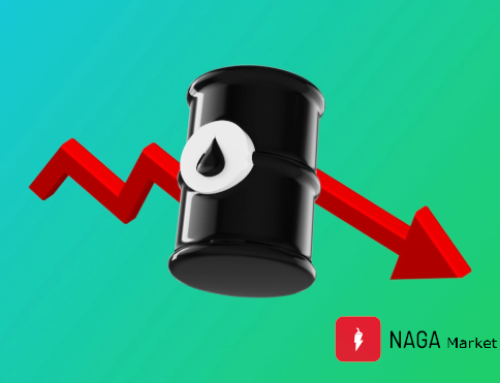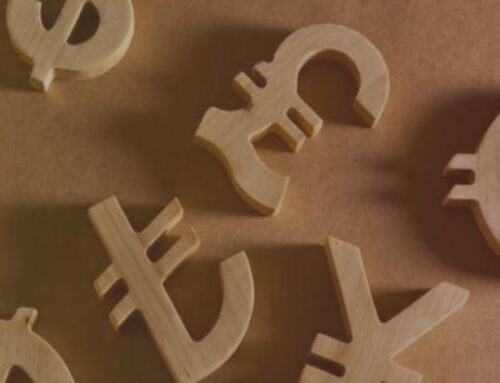11 / 03 / 2024
CN – EN | Oanda Labs | Introduction to USD (the US Dollar)
Translated from Chinese into English by Wordwide FX
Forex Trading: Understanding the United States Dollar
An introduction to the US Dollar: what you should know about the USD before trading it. What drives its value, key indicators and its relationship to US Bonds and gold.
This article describes the characteristics of the USD, the world’s most popular currency. It also describes the relationship between the USD and financial products such as bond yields and gold.
The biggest currency by trading volume
With the world’s most significant trading volume, the USD is often also bought as a safe haven asset.
As the currency of the United States, the world’s largest economic and military power, the US Dollar enjoys a unique “world currency” status and global acceptance across financial markets. In addition to being the most widely used currency for international trade and financial transactions worldwide, the Dollar also serves as the primary reserve currency for the central banks of numerous nations making it central to the global economy.
According to data released by the BIS, over 40% of forex trade in 2022 was in USD. Since the USD is traded worldwide and has high liquidity, it is considered a safe-haven currency with both JPY and CHF
The US Dollar is frequently regarded as a “safe haven” currency during times of market instability or geopolitical risk, and there is a strong tendency for investors to buy USD during these periods in order to diversify and de-risk their portfolios. However, since the terrorist attacks of September 11, 2001, there has been a growing trend towards selling the Dollar. Selling USD can therefore become viable, particularly when there is risk in the US, so it’s important to determine where the risk lies and take the appropriate measures depending on the circumstances.
What factors can affect the US Dollar?
Since the USD is the currency of the United States, the policies of the Federal Reserve, the US central bank, and core US economic indicators all significantly impact the value of the US Dollar.
The Federal Reserve’s monetary policy
The monetary policy of the United States is determined at eight meetings held annually by the Federal Open Market Committee (FOMC).
The market closely follows these meetings, with the focus being on the decisions, policy statements, chairman’s press conferences, and FOMC minutes, causing the US Dollar to sometimes overreact based on the direction of the monetary policy.
Generally, when the FOMC tightens monetary policy, the market tends to buy the US dollar. Conversely, when it loosens its policy, the market tends to sell the US dollar.
Economic Indicators in the United States
When the US economy is booming, the Federal Reserve tends to tighten monetary policy to prevent the economy from overheating and prices from rising.
Specifically, it raises interest rates in order to maintain economic stability.
Financial policies are also implemented to stimulate the economy when this slows down and the inflation rate falls.
When interest rates are cut and bonds become attractive, money flows into the market, stimulating the economy and driving price increases.
Generally speaking, financial policies that tighten the economy will increase the currency’s value, making it a factor in buying USD. Monetary policies that loosen the economy will reduce the currency’s value, making it a factor in selling USD.
However, suppose prices remain relatively high compared to other countries in the medium to long term. In that case, the currency’s value will fall according to the Law of One Price, which states that the price of the same asset will have the same price globally when certain factors are taken into consideration so it can also be a factor for selling.
What is the relationship between the US Dollar and Bond Yields?
Bond yields are a great indicator of the strength of a country’s stock market, which increases demand for the country’s currency. The relationship is fairly linear: any increases in US bond yields will likely increase demand and therefore price of the US dollar. As higher-yields are often favored by more risk-inclined investors, higher bond yields can also be a signal of the market’s risk tolerance expanding. This isn’t always the case but it is accurate most of the time.
Below is a chart comparing the US Dollar index to US 10-year and 2-year bond yields. As can be seen, the correlation is not always present.
For example, the chart below compares the USDEUR yield (1÷EUR/USD) and the US 10-year bond yield minus the German 10-year bond yield. The two data points are often moving in the same direction, so it may be easier to understand the direction of the general trend by comparing them in this way.
In the case of USD/JPY, the difference in yield between US bonds and Japanese bonds tends to be correlated, while in the case of GBP/USD, the difference in yield between US bonds and UK bonds tends to be related.
How does the price of Gold correlate with the United States dollar?
There is often a negative correlation between the US Dollar and gold.
That is, when the dollar rises, the price of gold falls, and when the dollar falls, the price of gold rises.
We find the same relationship when the value of money decreases and the price of goods rises and when the value of money increases and the price of goods falls.
Because crude oil is priced in US dollars, this inverse relationship is also present in the oil market, meaning that when the value of the US dollar falls, crude oil prices tend to rise, and vice versa. However, there are other fluctuations in the oil market due to a range of factors, such as supply and demand or geopolitical events. Gold is the most prone to exhibit a negative correlation with the US Dollar.
The chart below compares EUR/USD, Dollar Index expressed by USD strength and gold price. As can be seen, the correlation is strong.
If you divide 1 by the USD index, the above chart will be displayed upside down.
https://www.oanda.com/bvi-en/lab-education/assets/Forex/aboutfx-usd/
美元(USD)的特徵介紹-美元與公債殖利率、黃金等金融產品的關係
世界第一的交易量,也會作為避險資產被買入
美元作為經濟、軍事都是世界第一強國美國的貨幣,在市場上的信用度非常高。作為世界貨幣,除了在世界中的貿易以及金融交易中被使用以外,也是各國央行的主要儲備貨幣,在世界各國流通。
根據BIS發表的資料,2022年的各國貨幣交易佔比中40%以上的外匯交易是透過美元交易。
因為在全世界的交易中都有美元的影子,所以流動性非常強,市場迴避風險時除了買入日圓和瑞郎以外,美元也緊隨其後,具有避險貨幣的特徵。
【2022年的不同貨幣佔比率】
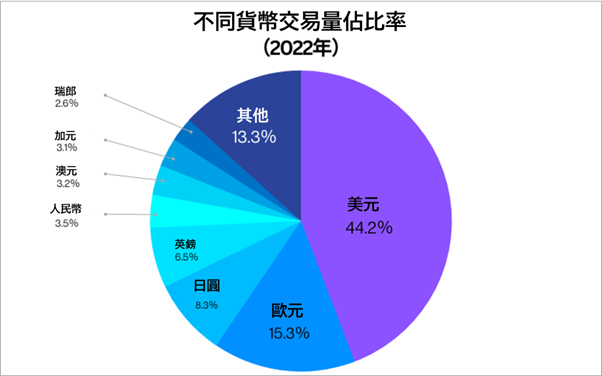
資料來源:BIS
不過,需要注意的是,以前市場上經常說”非常時刻買美元”,就是在世界局勢不穩定的非常時刻買入美元的傾向很強,但是,自從911恐怖事件以來,拋售美元的反應也越來越多。
特別是在美國出現風險時拋售美元的可能性很高,所以有需要確認好風險出現在哪一個地方,根據情況做好對應。
影響美元的要因
因為美元是美國的貨幣,所以美國央行美聯儲的政策以及美國經濟指標對美元的影響很大。
美聯儲的金融政策
美國的金融政策是由FOMC(聯邦公開市場委員會)每年舉行的的8次會議中決定。
FOMC的金融政策的決定事項、政策聲明以及主席記者會、會議記錄等都是市場關注的焦點,美元有時會根據金融政策的方向做出過激反應。
基本上是美國收緊金融政策時買入美元加強,放寬金融政策時拋售美元加強。
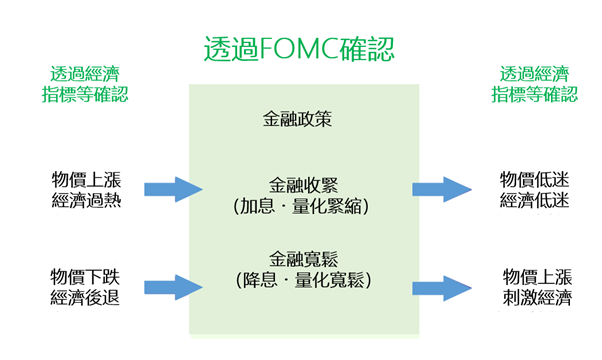
美國的經濟指標
美聯儲在美國經濟很好時,為了防止經濟過熱物價上漲,將會做出收緊金融措施。
具體就是通過加息來維持經濟平穩。
如果經濟減速,物價上漲率下跌時也將做出刺激景氣的金融政策。
具體就是通過降息、買入國債,讓市場上的錢流動起來刺激經濟,推進物價上漲。
一般來說,收緊經濟的金融政策將提升貨幣價值,所以會成為買入美元的材料。而放寬經濟的金融政策會降低貨幣價值,所以會成為拋售美元的材料。
不過,如果物價與其他國家相比,中長期一直處於比較高的狀態的話,根據一物一價的原則,貨幣的價值是處於下跌的狀態,所以也有可能成為拋售的材料。
與美國公債殖利率的關係
美國公債殖利率與美元的關係在市場風險容忍度擴大時,美國公債殖利率上漲將會成為買入美元的材料。但是,美國公債信用度下降時的利率上漲將會成為拋售美元的材料。所以利率的上漲原因對美元的影響不同。
下面是美元指數和美國10年、2年債殖利率相比較的圖表。可以看出,有時有相關性,有時沒有,所以很難找出雙方的相關性。
【美元指數和美國10年、2年債殖利率相比較的圖表】
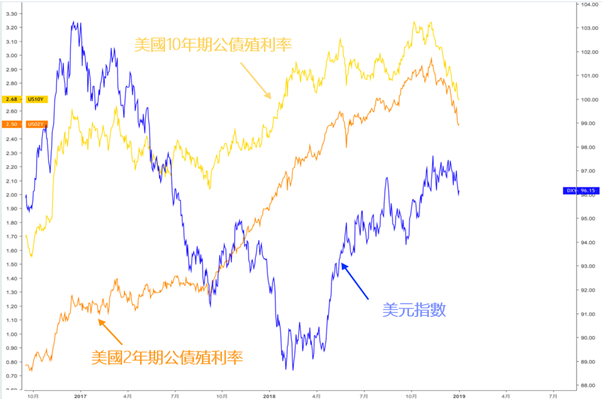
不過,外匯市場都是以貨幣對做交易,如果和另一個貨幣的國家的公債殖利率一起比較的話有時也會看出相關性。例如,下圖是USDEUR(1÷EURUSD)和美國10年公債殖利率減去德國10年公債殖利率的比較圖。2個數據的方向相同的時候比較多,所以,這樣相比較的話也許更容易掌握大趨勢的方向。
美元/日圓的話,美國公債與日本公債殖利率之間的差,英鎊/美元的話,美國公債與英國公債殖利率之間的差會容易出現相關性。
【USDEUR(1/EURUSD)與美國10年公債殖利率-德國10年公債殖利率相比較】
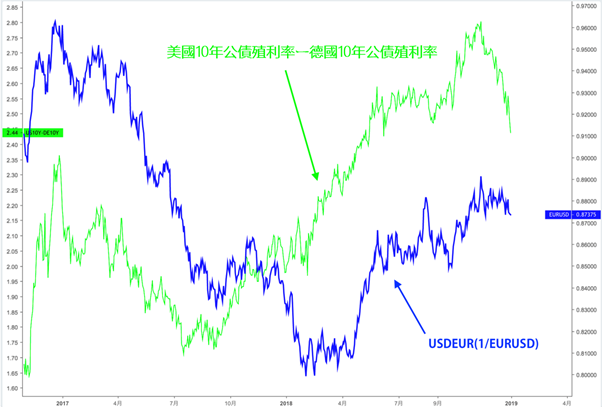
與黃金市場是負相關
美元與黃金市場往往有著負相關的關係。
也就是,美元上漲黃金價格下跌,美元下跌黃金價格上漲。和錢的價值下降商品的價格就會上漲,錢的價值上漲的話商品的價錢就會下跌的關係一樣。
原油市場也容易出現這種傾向,不過,原油市場因為其他原因上下波動的時候也很多,所以黃金市場最容易出現負相關性。
下圖是歐元/美元和按美元強弱來表示的美元指數以及黃金價格相比較的圖表。可以看出很強的相關性。
【黃金與美元波動的相關比較】
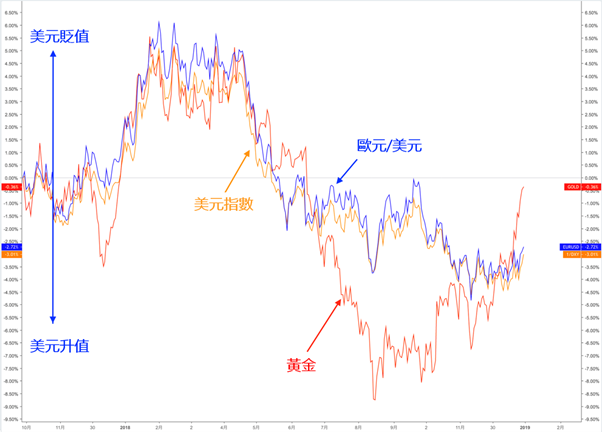
※用1除以美元指數,圖表就可以上下顛倒顯示。
美元(USD)的特徵介紹-美元與公債殖利率、黃金等金融產品的關係
世界第一的交易量,也會作為避險資產被買入
美元作為經濟、軍事都是世界第一強國美國的貨幣,在市場上的信用度非常高。作為世界貨幣,除了在世界中的貿易以及金融交易中被使用以外,也是各國央行的主要儲備貨幣,在世界各國流通。
根據BIS發表的資料,2022年的各國貨幣交易佔比中40%以上的外匯交易是透過美元交易。
因為在全世界的交易中都有美元的影子,所以流動性非常強,市場迴避風險時除了買入日圓和瑞郎以外,美元也緊隨其後,具有避險貨幣的特徵。
【2022年的不同貨幣佔比率】
資料來源:BIS
不過,需要注意的是,以前市場上經常說”非常時刻買美元”,就是在世界局勢不穩定的非常時刻買入美元的傾向很強,但是,自從911恐怖事件以來,拋售美元的反應也越來越多。
特別是在美國出現風險時拋售美元的可能性很高,所以有需要確認好風險出現在哪一個地方,根據情況做好對應。
影響美元的要因
因為美元是美國的貨幣,所以美國央行美聯儲的政策以及美國經濟指標對美元的影響很大。
美聯儲的金融政策
美國的金融政策是由FOMC(聯邦公開市場委員會)每年舉行的的8次會議中決定。
FOMC的金融政策的決定事項、政策聲明以及主席記者會、會議記錄等都是市場關注的焦點,美元有時會根據金融政策的方向做出過激反應。
基本上是美國收緊金融政策時買入美元加強,放寬金融政策時拋售美元加強。
美國的經濟指標
美聯儲在美國經濟很好時,為了防止經濟過熱物價上漲,將會做出收緊金融措施。
具體就是通過加息來維持經濟平穩。
如果經濟減速,物價上漲率下跌時也將做出刺激景氣的金融政策。
具體就是通過降息、買入國債,讓市場上的錢流動起來刺激經濟,推進物價上漲。
一般來說,收緊經濟的金融政策將提升貨幣價值,所以會成為買入美元的材料。而放寬經濟的金融政策會降低貨幣價值,所以會成為拋售美元的材料。
不過,如果物價與其他國家相比,中長期一直處於比較高的狀態的話,根據一物一價的原則,貨幣的價值是處於下跌的狀態,所以也有可能成為拋售的材料。
與美國公債殖利率的關係
美國公債殖利率與美元的關係在市場風險容忍度擴大時,美國公債殖利率上漲將會成為買入美元的材料。但是,美國公債信用度下降時的利率上漲將會成為拋售美元的材料。所以利率的上漲原因對美元的影響不同。
下面是美元指數和美國10年、2年債殖利率相比較的圖表。可以看出,有時有相關性,有時沒有,所以很難找出雙方的相關性。
【美元指數和美國10年、2年債殖利率相比較的圖表】
不過,外匯市場都是以貨幣對做交易,如果和另一個貨幣的國家的公債殖利率一起比較的話有時也會看出相關性。例如,下圖是USDEUR(1÷EURUSD)和美國10年公債殖利率減去德國10年公債殖利率的比較圖。2個數據的方向相同的時候比較多,所以,這樣相比較的話也許更容易掌握大趨勢的方向。
美元/日圓的話,美國公債與日本公債殖利率之間的差,英鎊/美元的話,美國公債與英國公債殖利率之間的差會容易出現相關性。
【USDEUR(1/EURUSD)與美國10年公債殖利率-德國10年公債殖利率相比較】
與黃金市場是負相關
美元與黃金市場往往有著負相關的關係。
也就是,美元上漲黃金價格下跌,美元下跌黃金價格上漲。和錢的價值下降商品的價格就會上漲,錢的價值上漲的話商品的價錢就會下跌的關係一樣。
原油市場也容易出現這種傾向,不過,原油市場因為其他原因上下波動的時候也很多,所以黃金市場最容易出現負相關性。
下圖是歐元/美元和按美元強弱來表示的美元指數以及黃金價格相比較的圖表。可以看出很強的相關性。
【黃金與美元波動的相關比較】
※用1除以美元指數,圖表就可以上下顛倒顯示。
Translated from Chinese into English by Wordwide FX
Forex Trading: Understanding the United States Dollar
An introduction to the US Dollar: what you should know about the USD before trading it. What drives its value, key indicators and its relationship to US Bonds and gold.
This article describes the characteristics of the USD, the world’s most popular currency. It also describes the relationship between the USD and financial products such as bond yields and gold.
The biggest currency by trading volume
With the world’s most significant trading volume, the USD is often also bought as a safe haven asset.
As the currency of the United States, the world’s largest economic and military power, the US Dollar enjoys a unique “world currency” status and global acceptance across financial markets. In addition to being the most widely used currency for international trade and financial transactions worldwide, the Dollar also serves as the primary reserve currency for the central banks of numerous nations making it central to the global economy.
According to data released by the BIS, over 40% of forex trade in 2022 was in USD. Since the USD is traded worldwide and has high liquidity, it is considered a safe-haven currency with both JPY and CHF
The US Dollar is frequently regarded as a “safe haven” currency during times of market instability or geopolitical risk, and there is a strong tendency for investors to buy USD during these periods in order to diversify and de-risk their portfolios. However, since the terrorist attacks of September 11, 2001, there has been a growing trend towards selling the Dollar. Selling USD can therefore become viable, particularly when there is risk in the US, so it’s important to determine where the risk lies and take the appropriate measures depending on the circumstances.
What factors can affect the US Dollar?
Since the USD is the currency of the United States, the policies of the Federal Reserve, the US central bank, and core US economic indicators all significantly impact the value of the US Dollar.
The Federal Reserve’s monetary policy
The monetary policy of the United States is determined at eight meetings held annually by the Federal Open Market Committee (FOMC).
The market closely follows these meetings, with the focus being on the decisions, policy statements, chairman’s press conferences, and FOMC minutes, causing the US Dollar to sometimes overreact based on the direction of the monetary policy.
Generally, when the FOMC tightens monetary policy, the market tends to buy the US dollar. Conversely, when it loosens its policy, the market tends to sell the US dollar.
Economic Indicators in the United States
When the US economy is booming, the Federal Reserve tends to tighten monetary policy to prevent the economy from overheating and prices from rising.
Specifically, it raises interest rates in order to maintain economic stability.
Financial policies are also implemented to stimulate the economy when this slows down and the inflation rate falls.
When interest rates are cut and bonds become attractive, money flows into the market, stimulating the economy and driving price increases.
Generally speaking, financial policies that tighten the economy will increase the currency’s value, making it a factor in buying USD. Monetary policies that loosen the economy will reduce the currency’s value, making it a factor in selling USD.
However, suppose prices remain relatively high compared to other countries in the medium to long term. In that case, the currency’s value will fall according to the Law of One Price, which states that the price of the same asset will have the same price globally when certain factors are taken into consideration so it can also be a factor for selling.
What is the relationship between the US Dollar and Bond Yields?
Bond yields are a great indicator of the strength of a country’s stock market, which increases demand for the country’s currency. The relationship is fairly linear: any increases in US bond yields will likely increase demand and therefore price of the US dollar. As higher-yields are often favored by more risk-inclined investors, higher bond yields can also be a signal of the market’s risk tolerance expanding. This isn’t always the case but it is accurate most of the time.
Below is a chart comparing the US Dollar index to US 10-year and 2-year bond yields. As can be seen, the correlation is not always present.
For example, the chart below compares the USDEUR yield (1÷EUR/USD) and the US 10-year bond yield minus the German 10-year bond yield. The two data points are often moving in the same direction, so it may be easier to understand the direction of the general trend by comparing them in this way.
In the case of USD/JPY, the difference in yield between US bonds and Japanese bonds tends to be correlated, while in the case of GBP/USD, the difference in yield between US bonds and UK bonds tends to be related.
How does the price of Gold correlate with the United States dollar?
There is often a negative correlation between the US Dollar and gold.
That is, when the dollar rises, the price of gold falls, and when the dollar falls, the price of gold rises.
We find the same relationship when the value of money decreases and the price of goods rises and when the value of money increases and the price of goods falls.
Because crude oil is priced in US dollars, this inverse relationship is also present in the oil market, meaning that when the value of the US dollar falls, crude oil prices tend to rise, and vice versa. However, there are other fluctuations in the oil market due to a range of factors, such as supply and demand or geopolitical events. Gold is the most prone to exhibit a negative correlation with the US Dollar.
The chart below compares EUR/USD, Dollar Index expressed by USD strength and gold price. As can be seen, the correlation is strong.
If you divide 1 by the USD index, the above chart will be displayed upside down.



